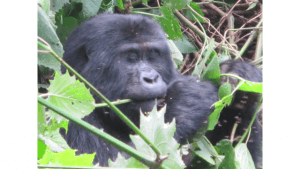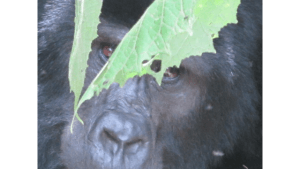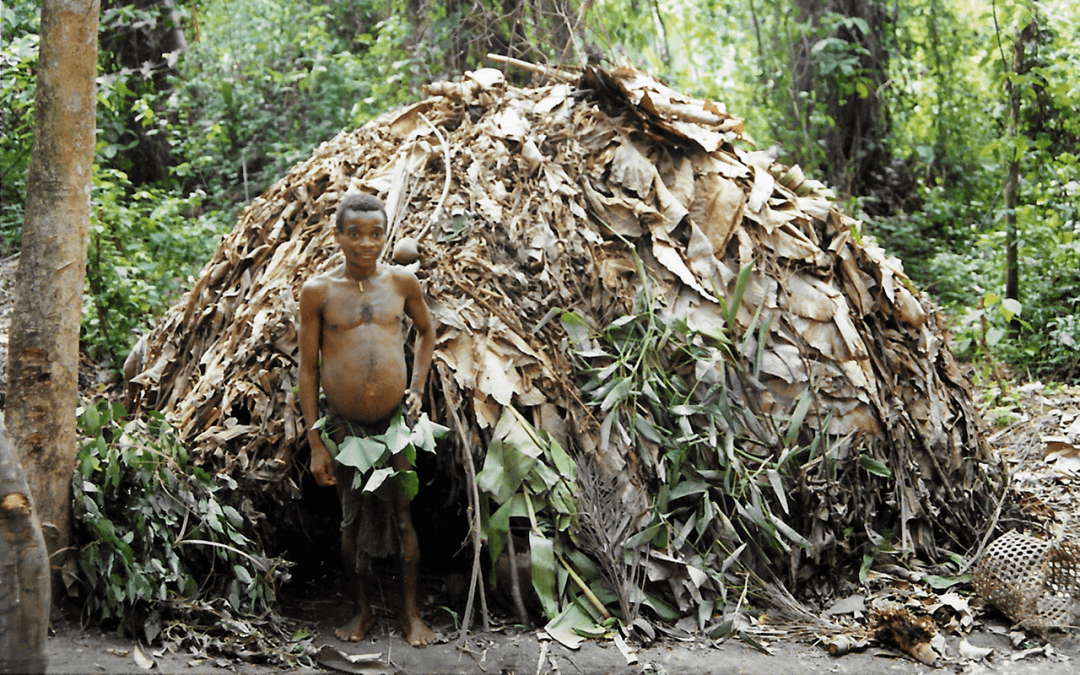
How To Save The Pygmies
A group of missionaries in the Congo was collecting money to translate the Bible into a tribal language for Efe pygmies. I could not donate until I traveled to the Ituri National Forest to evaluate the situation for myself.
Turns out, the gentle Efe are already good people–one of only two cultures in the world with no incidence of rape. They also have religion, sharing creation myths and believing in the spirits of the forest. Could something irreplaceable be lost in this translation project?
The Trip
After an eight-hour jeep trip on an impossible road, my two friends and I boarded a dugout pirogue and traveled deep into the rainforest, the humidity increasing with each kilometer. A short, sweaty hike along a dense path took us to a clearing, where the village sat below thick leafy foliage, shading the afternoon sun. We found a smattering of igloo-shaped huts with mongongo leaves (from a nut tree) covering frames made of bent saplings. Campfire embers sent up wisps of smoke.
The Pygmies
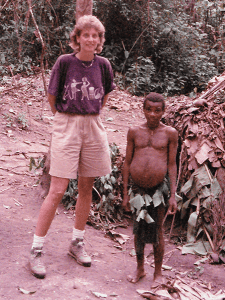 Pygmies are born an average human size but growth slows down at puberty, with males reaching four foot eleven and females four foot nine. Their weight is proportionate to their height. And as hunter-gatherers, they are agile and light on their feet.
Pygmies are born an average human size but growth slows down at puberty, with males reaching four foot eleven and females four foot nine. Their weight is proportionate to their height. And as hunter-gatherers, they are agile and light on their feet.
An older woman—so to speak, forty is the life span—wearing only a leaf skirt, sat on the ground by the campfire. She tended to three well behaved children and smoked what looked like a joint while the strong scent of cannabis filled the air. She gazed at us with a far-away look and mumbled to our guide that the men were out hunting, and, just in case, the women had walked to a market to trade forest products and/or labor for produce and grains.
Songs, whistles, and shouts soon emanated from the forest. Pygmy men in bark loin cloths tromped into the village and welcomed us. They burst into a spontaneous culture show, with drumming, piping, and dancing that went on forever. We grew uncomfortable. We assumed they were lobbying for a large tip, but actually continuous music is one of their signature cultural practices. We smiled, enjoyed the first ten minutes, and made peace with the rest. Later a group of equally-gracious women arrived bearing fruit and vegetables.
The Monkey Hunt
The next morning a barefoot troop of men, armed with bows and poison-tipped arrows, led us through the rainforest. They were adorned with monkey fur, indicating the forest was not deplete of game. Yet though we spotted a few ruffles in the treetops, no monkey would be caught that day.
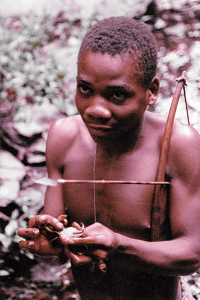
A young man led us to a beautiful waterfall with some tiny crabs he could take home for snacks, I presume. We thought we were alone, but every time we snapped a picture, a pygmy jumped out of the forest and photo-bombed our shot. Surprise! Then he would flip out an upturned palm.
This plus the sale of inferior tourist-quality instruments at the end of our morning made us sad about the way the Efe changed their behavior, cheapened their traditions, around foreigners. Normally they hunted, gathered, tended to their families, and made music. That day they did meaningless stuff that probably made them as uncomfortable as it made us. But it was necessary. Their habitat is shrinking, and if hunting doesn’t serve them, they must have money to survive.
“When the forest dies, we shall die.” (Erin Fitz-Henry quoting the Efe people)
And it’s true: saving the pygmies means saving their rainforest habitat, from the loggers, poachers, and war lords. So I have put my efforts into publicizing the plight of the pygmies. As for salvation, the Bibles were eventually finished, but I’m pretty sure God already loved them anyway.
Postscript: After my visit, civil war broke out. National Geographic tells the story of the pygmies during and after the war. Innocent and sincere, they did not fare well. Their pacifism and size made them easy prey for rapists and cannibals.

Never Run from a Gorilla
Dianne Fossey risked her life to save the mountain gorillas from poachers. But someone got to her. And her loss was huge for the preservation effort. According to The Guardian, between her death and May, 2012, over 130 park rangers have been killed. Of course, I didn’t know this when I booked my ticket to visit the gorillas. I just knew when I moved to the Congo that if I wanted to commune with the gentle giants, I should act quickly. And I did.
Prep for the close encounter
With the tour packet came my tickets and two directives: “Never run from a wild animal,” and “Never look a silverback in the eye.” For a month, these phrases became my mantra—even though I figured I would never get close enough to worry about it.
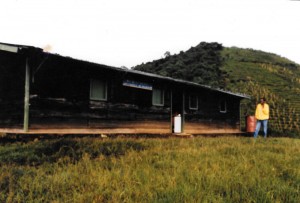
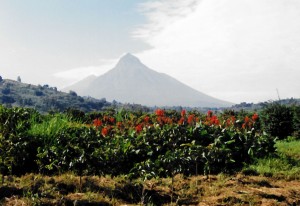 Over spring break, five friends and I flew from our home in Kinshasa to Eastern Congo, and in the evening arrived by jeep at a wooden hut high in the Virunga Mountains.
Over spring break, five friends and I flew from our home in Kinshasa to Eastern Congo, and in the evening arrived by jeep at a wooden hut high in the Virunga Mountains.
At the crack of dawn, the bushwhacker led us into the forest while rain pelted our plastic ponchos. To the rhythmic thwack, thwack of his machete, we trudged uphill, hands gloved against the thickening bush. The shot-gun armed guide held rear guard in the semi-darkness. Would the sun never rise on these Virungas?
After forty-five minutes the rain dissipated, and the mist arrived. Now, bring on the gorillas. Our guide stopped and raised his hand for silence. Six curious women froze in place, listening.
Enter the Silverback
The crunching sound of giant teeth chomping on bamboo came from the left. The tall bush separated as something ominous plowed our way. My senses switched to high alert. Never run from a wild animal. Never run . . . . And there he was. Blood rushed to my muscles and prepared them for flight.
 I saw the top of his head first. A huge, black fur ball. And then the shoulders, wide and powerful. The arms out in front propelled the silverback my way. I dug my heels in the ground and tried to back pedal, to give way to the giant heading at me. But my so-called friends jammed their hands into my back and pushed me forward. Our opposing forces kept me in the danger zone. The gorilla stopped before me and cranked his head toward my face.
I saw the top of his head first. A huge, black fur ball. And then the shoulders, wide and powerful. The arms out in front propelled the silverback my way. I dug my heels in the ground and tried to back pedal, to give way to the giant heading at me. But my so-called friends jammed their hands into my back and pushed me forward. Our opposing forces kept me in the danger zone. The gorilla stopped before me and cranked his head toward my face.
“Look down! Look down!” Everyone whispered. You didn’t need to tell me twice. I deferred to the silverback’s power and stared at the ground, where his giant knuckles supported long, sinewy arms. His wing span was wide enough to squeeze all six of us together and hurl our deflated bodies back to base camp. He didn’t. He stood at attention, daring us to challenge his authority. We didn’t. The guide, kneeling by my side, spoke to him. Softly. Gently. In Swahili.
We waited. Me, the reluctant shield, protecting five petrified women. Him, the victor, snorting warm breath at my bowed head.
The test ended just like that. We were rendered harmless and released from probation. He rolled his head forward and lumbered on, the silver-white fur down his back disappearing into the thicket.
Kids do the cutest things
We followed the silverback to a clearing where he fell asleep, fully trusting us to enjoy his troop of thirteen mothers and babies, playing nearby. We were so close that I understood why authorities had limited the number of visitors to eight per day. The little ones can die from human illnesses, like measles.
A juvenile with Ace Ventura hair entertained himself by looking at his funny reflection in my friend’s belt buckle. Other juveniles grabbed at our cameras and hats or just stared in amazement at what silly creatures we must have seemed. We do share 98 percent of our DNA, and so each group must have recognized similar expressions and monkey business in the other. After an hour of play the silverback led the troop away, leaving behind six astounded women.
Where you can see gorillas
Virunga is a new movie showing the efforts to protect the Virunga mountain gorillas. I applaud their courage, but I would not recommend touring in Congo just yet. According to The Guardian insurgents have been interfering with gorilla tourism, and you never know if the park will be open. A safer bet is visiting one of the mountain gorilla sanctuaries in neighboring countries. One is Rwanda, where Dianne Fossey went after fleeing the Congo. The other is Uganda, where my friends, Hank and Helen Henry, took these photos a little over a year ago (without a telephoto lens, I’m sure).
Visiting the gorillas in their natural habitat is life-changing. It challenges you and delights you at the same time. Gorillas are powerful yet gentle; the contrast between appearance and reality is stunning. They will test your courage, and then make you fall in love.
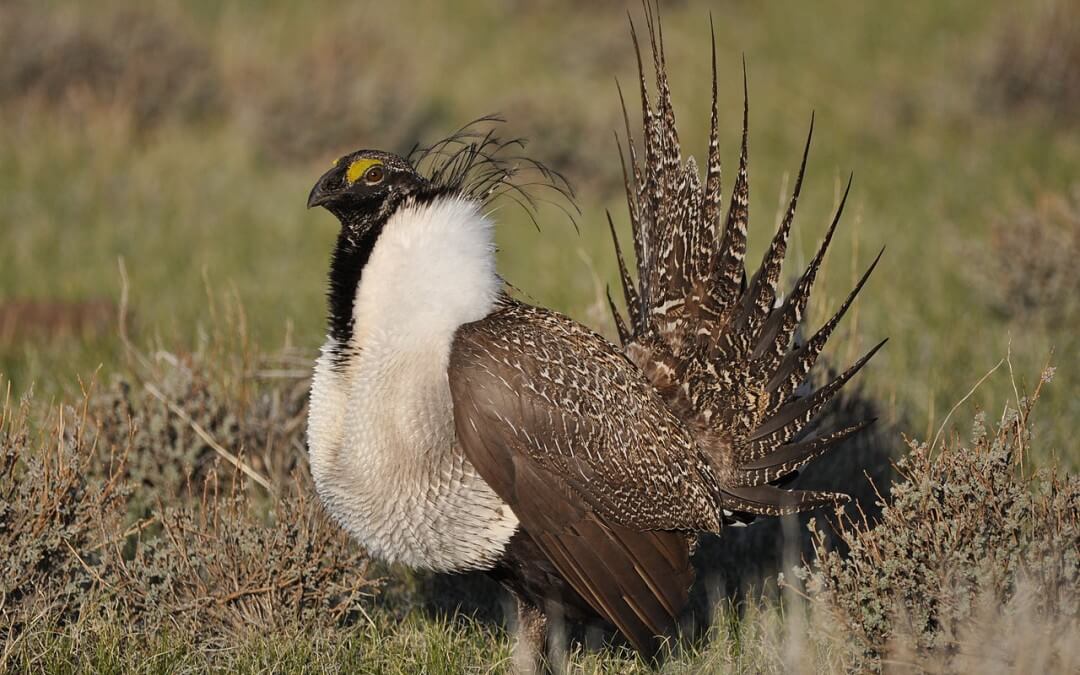
What’s A Gun Got To Do With It?
 Pop the corks! Cock your guns! The Centennial Celebration of the National Park Service has begun— with an armed take-over of the Malheur National Wildlife Preserve in Oregon.
Pop the corks! Cock your guns! The Centennial Celebration of the National Park Service has begun— with an armed take-over of the Malheur National Wildlife Preserve in Oregon.
The National Park Service, John Muir’s greatest achievement, facilitates what he called “essential democracy,” equal public access to the wonders of nature and preservation of natural beauty and wildlife for posterity.
But a couple of Bundys are actually fighting the concepts of “equal” and “preservation.” Not the funny Bundys, Al and Peg. No laughs here. It’s the gun-slinging Bundys and their militia now holed up in the park headquarters building.
For two years I have been planning a trip to Malheur, but as the time draws near I may be out of luck because the imminent danger has closed the park.
What will I miss?
The unique and elaborate mating ritual of the greater sage grouse, which happens only from February to April. For hours in the very early morning, the males puff up their chests, fan out their spiky, mottled tail feathers, and strut their stuff on the lek, the West’s ancestral mating grounds in the Sagebrush Sea. When females gather round, the males work hard for the payoff, putting on an incredible show. Competition is fierce, and only a few males win, so, conceivably, one could mate with eighty females while the guy next to him remains frustrated until next spring. Check out this video.
How’s that Endangered Species List Working Out?
In 2010 the sage grouse was declared endangered. This led to cooperation between local ranchers and the Bureau of Land Management. And although the breeding grounds have greatly shrunk, the two groups worked together well enough to not only preserve the population but increase it to the point where the species could be removed from the list last September. Working in concert is a beautiful thing.
 Continuing to conserve the sage grouse benefits their population as well as those species who share their habitat, like elk, mule deer, trout and almost 200 resident and migratory bird populations, including sandhill cranes. But if the militia have their way, the breeding grounds will be given over to grazing for cattle.
Continuing to conserve the sage grouse benefits their population as well as those species who share their habitat, like elk, mule deer, trout and almost 200 resident and migratory bird populations, including sandhill cranes. But if the militia have their way, the breeding grounds will be given over to grazing for cattle.
The Dangerous Intersection of Ranchers and Government
American history is full of land use conflicts between ranchers and government authorities. But according to last week’s NPR interview with Judge Steve Grasty, Oregon’s Harney County has a history of working out its own problems. Citizens did not call for Ammon Bundy and his band of militia to travel from out of state to fight their battle. When the trespassers were told they weren’t welcome, they refused to leave, so Grasty is billing them for their stay.
The militia see themselves as Robin Hoods, fighting against the big bad government. But hold on there, pardner. The government R us, you and me. The militia want to take land from the many and give to the few. They want to end the national public trust so locals can decide local issues. Sometimes local decision-making works, such as when parties compromise like those in Harney County. But following the Bundy logic and privatizing all American land will work against the common good.
Some areas of our country are just too valuable to be left to the whims of a small group’s immediate wants. This is why one hundred years ago John Muir fought to stop the loggers from decimating the redwood trees inside Yosemite. Some American land must revert to the public trust in the best interest of all, which includes the preservation of the wildlife at Malheur.
So for the good of mankind, the Bundys should take themselves and their guns back to wherever they come from these days, be that Idaho or Arizona, where, by the way, unregulated land use has already wiped out that state’s sage grouse population.
*Photo Credit for Greater Sage Grouse: Jeannie Stafford/USFWS
Next week: Never Run From a Gorilla

